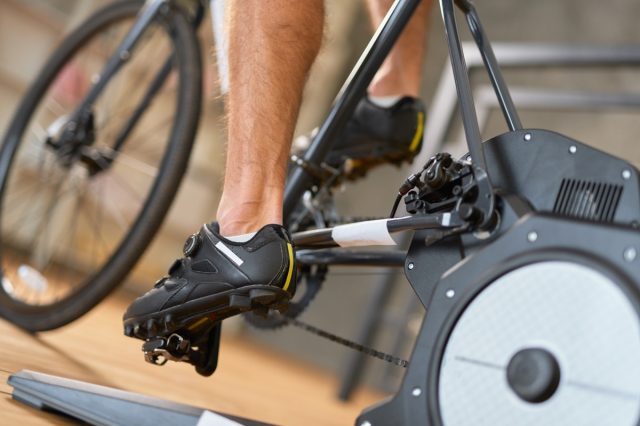How to Design a Super-Effective Strength-Training Workout

If you're trying to build muscle and gain strength, you need to be on a strength-training program. A lot of people make the mistake of just going about their workouts with no rhyme or reason. They also sometimes wing it with exercises that they like, but unfortunately, that often doesn't lead to results.
When you're on a proper program that's consistent, well-rounded, and manageable with your lifestyle and skillset, you'll know exactly what to do and how to make progress over time to reach your fitness goals. The right strength-training program will also emphasize compound movements and address any weaknesses you may have.
Not sure how to design an effective strength-training workout? I gotcha covered. Let's break it down! And for more, don't miss my recommendations for The 5 Best Pieces of Gym Equipment You Need at Home.
Determine Your Frequency

First off, let's figure out what your fitness levels are and how many times a week you can work out.
If you're a beginner or short on workout time, I highly recommend performing full-body workouts. All of your muscles get stimulated throughout the week, and you'll build strength quickly. A basic 3-workouts-a-week schedule is good enough, and this is how it should look:
Monday: Full Body
Wednesday: Full Body
Friday: Full Body
If you're a bit more experienced and have more days to work out, then you can do an upper/lower body split. This allows you to train your entire body throughout the week evenly while allowing the muscles to recover in between. This is how I usually set it up:
Monday: Upper Body
Tuesday: Lower Body
Thursday: Upper Body
Friday: Lower Body
For the even more experienced, you can do a body part split, which allows you to target individual muscles with more exercises. The problem is, recovery can be tough and not ideal for busy people, since missing a day throws off the routine and flow of the program. You'll also need to ensure that you're sleeping well and your nutrition is on point. Here is what a body part split would look like:
Monday: Chest
Tuesday: Legs
Wednesday: Back
Thursday: Shoulders
Friday: Arms/Calves
Related: Sign up for our newsletter for the latest health and fitness news!
Choose Your Exercises

When selecting your exercises, you want to lead with compound movements (ones that use more than one muscle group at a time). These will get you the most bang for your buck, and you can make the most progress with them.
The best compound movements are the following:
-Press (bench press, shoulder press)
-Pull (pullups, pulldowns, rows)
-Squat (Dumbbell, barbell)
-Hinge (deadlift, hip thrust)
Pick 2-3 compound movements based off of the body parts you're working, then move on to single-joint exercises.
Here are some examples of single-joint exercises:
-Single-Leg Movements (lunges, split squats)
-Bicep Curls (dumbbell, barbell, cable)
-Triceps Extensions (dumbbell, barbell, cable)
-Shoulder Lateral Raises
-Calf Raises
– Ab Exercises (crunches, situps)
Related: These Are the 5 Highest-Paid Celeb Personal Trainers on Instagram
Pick a Sets + Reps Scheme

Now that we've mapped out your exercises, it's time to pick the number of sets and reps to do for each move!
In the beginning of the workout, you want to emphasize heavier weight and fewer reps with your compound movements. Some of my favorite rep schemes for strength are: 3 sets of 5 reps, 4 sets of 5 reps, or 4 sets of 6 reps.
Once the heavy lifting is out of the way, now is the time to focus on hypertrophy, aka training for muscle size with high reps. Higher rep training leads to something called sarcoplasmic hypertrophy in your muscle fibers, which increases the fluid in the muscle and causes it to get bigger.
Here are rep schemes for hypertrophy: 3 sets of 8-10 reps, 4 sets of 8-10 reps, or 3 sets of 15-20 reps.
Related: Exercises You Should Never Skip As You Age
Add Cardio Conditioning

Even though you're on a strength-training program, you shouldn't neglect cardio or conditioning work.
After all of your lifting is done, if you have any time left over, you can work on your cardio and conditioning. This is used to improve your endurance, performance, and also to give you a nice little fat burn effect to cap off your workout.
If you're short on time, I recommend doing 10-15 minutes of interval-style training. There are many different ways to do this. Some of my favorite tools are kettlebells, the assault bike, battle ropes, a rowing machine, or medicine ball complexes.
You can set a timer and use any of those pieces of equipment to perform a 1:1 or 1:2 work-to-rest ratio. An example would be doing kettlebell swings for 30 seconds, then resting for 30 or 60 seconds before performing another set. Do that for 10 minutes total and you're all set!
If you don't have much energy left after your workout, you can simply go for a fast-paced walk. Walking is a very underrated tool for fat loss. You can do it outside, or one of my favorite modalities is to hop on a treadmill, set it a 15-degree incline, and walk at 3-3.5 mph for 15-20 minutes.
For more, check out This 20-Minute Toning & Slimming Workout.








